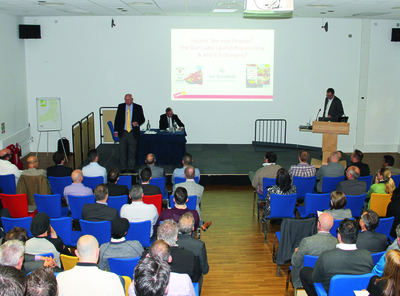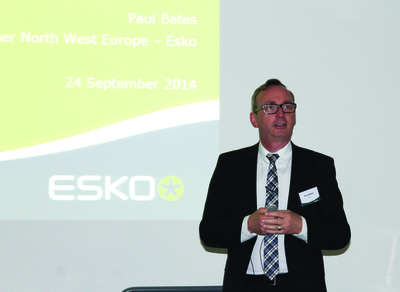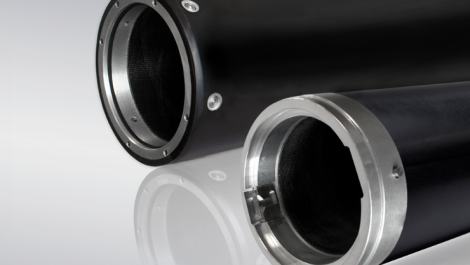Paul Bates, business manager North West Europe, welcomed the users
Esko gathered its users at the annual EskoWorld UK conference on 24 September at Loughborough University. The comprehensive programme gave attendees an overview of new trends in packaging as well as detailed presentations on the company’s solutions.
‘Today is about inspiration and innovation,’ said Paul Bates, business manager North West Europe, in his welcome speech. ‘We want to be at the forefront of technology and make sure that we have the right products for our users. This event is an important opportunity for us to get your feedback and for you to ask questions. We want the sessions today to be interactive and invite audience participation.’
Automation of workflows was high on the agenda with speakers advocating ‘lights out’ production, ie the idea that a plant will keep production going whether the lights are on or off as full automation has been implemented throughout.
Fresh is king
Looking at key trends in packaging, Jan de Roeck, who is Esko’s director of solutions management, talked about how developments in packaging is influencing the company’s products, and pointed to some of the business opportunities available to customers.
He said, ‘The concept of the megastore is under a lot of pressure with many shoppers choosing to shop local and fresh. Global brands are also adapting to this change in behavior and producing local versions of their products. It is all about appealing to the consumer as an individual.’
One of the consequences of this ‘going local’ trend is the need for shorter print runs – an opportunity for digital printing with all its abilities of personalisation, versioning and on demand production.
Getting noticed as a brand in the busy market place is increasingly challenging for brands. Mr de Roeck showed an example from the luxury drinks sectors where printing has enabled the brand to stand out on shelf via flexo printed circuits that light up the packaging. He said, ‘Could this be a business opportunity for you? We have customers using ArtPro and our editing tools to handle the files for the printed electronics.’
Reducing (food) waste Mr de Roeck illustrates this with an example of how ‘food can talk to you’ – a pack of fresh pears featuring a freshness indicator which reads the bacteriological content of the air inside to let the consumer know when they fruit is past its best use. Other ‘smart’ packaging includes pharma packs that remind the patient to take the medication and monitors the use, particularly useful for Alzheimer’s sufferers.
Lightweigthing is still a strong driver in packaging development and Esko’s software can be used to take out weight of packaging.
With all these new technologies, packaging becomes a means of communicating directly with the consumer. Taking this one step further, Mr de Roeck sees more business opportunities for converters in that they already have the information needed to present to the consumer online. New legislation demands the listing of ingredients and nutritional values of each product chosen when grocery shopping online. This also applies to interactive packaging through platforms such as Blippar where the label is the gateway to a whole world of information. Here there is an opportunity to help the brand owner develop the content.
For converters, this means a move from simply being a supplier towards becoming a business partner with the brand owner, achieved through complementing their core competences, adding values to solutions and most importantly implementing full workflow automation. Mr de Roeck said, ‘Operators will have to work smarter and focus on quality assurances. They will become the guardians of workflow automation.’
Finally, he listed the five key directions that he predicts the future will take. First of all, workflow automation shifts production to a ‘lights out’ environment. Secondly, ‘smart’ templates rule – ‘we can’t have the operator creating every type of packaging individually.’ Thirdly, quality comes first, and fourthly, interactive editing is task driven. As the key enabler, the supply chain will be integrating on the web with the Cloud as default storage.
View from the shop floor
Following up on Mr de Roeck’s talk on the future of workflow automation, Ian Schofield from supermarket chain Iceland gave a fascinating talk on the daily challenges he faces as the retailer’s own label and packaging manager. He said, ‘I’m going to automation as fast as I can get there. The Cloud is a great help to me as a retailer. It’s all about speed and connectivity.’
One of the challenges is the fast growing discount market with smaller, local stores increasing, including the likes of Aldi and Lidl. Iceland is positioned in the middle as a crossover between the large destination superstores and the high street discount stores. Mr Schofield said, ‘We have a fight on our hands and we can’t change our stores, but we can change the packaging. Smart suppliers are already tailoring their offering to meet this challenge, as are we.’

Ian Schofield, own label and packaging manager at Iceland, gave the retailer’s view of the changing market
From a printing perspective, Iceland has converted large parts of its packaging to four colour flexo, having made some acceptable compromises which in return offered ‘double digit savings’. All new products are printed in HD Flexo and Mr Schofield said that the quality is so good that he does not need to go to the printers to check what is coming off the press. He said, ‘Everything has to be predictable. I do not want to travel around the world to print runs.’
The constant changes to the packaging means that 80% of jobs are never repeated. Smaller runs are becoming the norm and Mr Schofield predicts that digital is going to have a massive effect on retailers. He also believes that for flexo continuous printing sleeves will become more and more popular as the price comes down.
Software news
Diving into the minutiae of the company’s pre-press software solutions, a detailed technology update followed from Wim Fransen, product group director interactive application software, and Frank Woltering, product manager interactive pre-media applications, who explained the changing role of interactive editors, including ArtPro, DeskPack and PackEdge.
As workflow automation shifts to ‘lights out’, ie full automation, the editors will be used to create ‘smart’ templates, verify result and assure quality, and to handle those tasks that can’t be automated or don’t fit into the templates.
Esko has also launched Knowledge Base, an online help tool, which can be accessed directly from the ArtPro, DeskPack and PackEdge. This help function is available for all users. Other new developments include support for all PDF Pageboxes, dynamic text marks and the ability to trap in multiple sessions, amongst many others.
A brand owner analysis has identified that as much as 58% of mistakes is down to copy being entered wrong. There are many file formats and getting the words onto the packaging can be tricky. Therefore Esko is introducing an online editor in conjunction with Chili Publish. This means that text can be entered directly into the artwork template (which has been uploaded to WebCenter) using a web browser. The master will then be updated automatically in Illustrator. The result is fewer approval cycles, fewer errors and cost savings.
To improve the user experience and boost productivity, a new intuitive toolbox has been introduced in ArtPro+. A pop-up wheel appears where and when needed which means less keystrokes and less movement is needed.
A LinkedIn user group has also been set up to offer a platform for feedback, and DeskPack is now available on subscription for low upfront investment.
Flexo track
The break out sessions in the afternoon followed three different tracks, flexo, sign & display, and graphics. Pascal Thomas, flexo business development manager, laid out the flexo roadmap talking the group through new developments and the company’s future plans.
After starting out with a bit of history (did you know the first CDI introduced at drupa 1995 was called George and that today there are over 2500 CDIs installed worldwide?), Mr Thomas said that HD Flexo, with almost 1000 installations, is used in all areas of packaging, but he noted, ‘It is not enough to simply install HD Flexo. This has to be backed up by making sure that the rest of the platemaking process is high quality too.’ He then went through the advantages of Full HD Flexo, which has recently been installed at the 100th site.
Current projects in flexo include more research into extended gamut printing and the introduction of a digital UV LED back exposure unit. The automation of the back exposure in combination with Inline UV2 will be the final step towards full digitalisation of the platemaking process and ties in with Esko’s ‘lights out’ production mantra to present a complete ‘CDI plate factory’.
Other new developments include a new high res optics box for Optic 80, which promises to increase productivity on HD Flexo by 50%, followed by a similar upgrade of Optic 120 which be going into beta testing early next year. Software news include Digital Flexo Suite 14 for up to eight cores, also addressing the use of dual/quad cores, and a LEN Explorer search engine. Furthermore, the Digital Flexo suite will be moving to Automation Engine, which will enable it to connect directly with the CDI and Kongsberg cutting table. Alpha testing starts in summer 2015.
The last flexo session of the day came from Dan Pulling, business development manager, who spoke about the latest development in colour and Esko’s products for colour management: FlexProof, Color Engine and Equinox, and the new colour module in Automation Engine which supports extended gamut printing.






